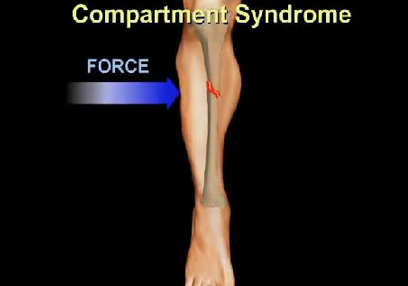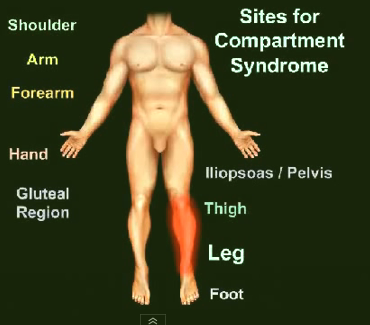What is Compartment Syndrome?
It is a rare, neuromuscular disorder that results from exercise and leads to experience of inflammation, pain and occasionally even disability of the affected muscles in the arms and legs.
Any individual can get affected by compartment syndrome. However, the condition is more common in athletes who engage in strenuous activities and sports that have cyclic movements such as brisk walking, running, swimming and biking. Compartment syndrome is also known by other names such as chronic compartment syndrome, chronic exertional compartment syndrome and exercise-induced compartment syndrome.
Traditional treatment methods usually don’t aid in alleviation of the symptoms of compartment syndrome. Surgery is generally used to treat compartment syndrome, which allows recreational and as well as professional athletes to go back to following their sport.
Symptoms of compartment syndrome
The pain and other signs and symptoms that accompany compartment syndrome, generally elicit the following characteristics:
- The affected limb may experience cramping, flaming or aching pain. The lower leg is most often affected, but the pain may also affect the upper arm, hand, thigh or hand.
- Tingling or numbness of the limb that gets affected
- There may be protrusion or selling on occasions, due to presence of muscle hernia
- The muscles of the affected limb may become tight
- The affected limb may experience fatigue or weakness
- In extreme cases of compartment syndrome, there may be foot drop due to the leg nerves getting affected
The pattern of pain that an individual with compartment syndrome experiences is discussed below:
- The pain starts once an affected individuals begins to exercise the affected limb
- The pain progressively becomes worse till the time one continues to exercise
- When the affected limb is rested, then the pain may subside after 15 to 30 minutes
- With the passage of time, a person with compartment syndrome may experience the pain for longer periods after stoppage of exercise. Sometimes, the pain may persist for even a day or two.
When a person with compartment syndrome completely stops exercising, then the symptoms may abate, albeit temporarily on most occasions. Once the affected person takes to exercising again, then the symptoms tend to return
Causes
The legs and arms contain many compartments or groupings of muscles, nerves and blood vessels. Every one of these compartments are enveloped by a solid layer of connective tissue known as fascia, which balances the tissues inside each compartment in their proper place and also holds up the different compartments. The fascia has almost nil elasticity and therefore cannot be stretched.
When individuals with compartment begin exercising or engage in acts that involve repetitive muscle contraction, the pressure of the tissues inside a particular compartment rises to abnormally high levels. Since fascia is not elastic, the tissues in that compartment cannot stretch to accommodate the additional, increased pressure.
The accumulation of pressure within an affected compartment without any possible options for its release, results in compression of the blood vessels and nerves. This can in turn lead to decreased supply of blood to the affected tissues, thereby decreasing the flow of oxygen to the tissues, which can then cause damage to the muscles and nerves
Doctors are not aware of the reasons that cause the buildup of excessive pressure within the compartments in people with compartment syndrome, when they begin exercising or engage in repetitive muscle movements. A few studies suggest that the method of exercising, which include the landing of foot while running or the manner of leg movements, etc., may be one of the causes. Other studies indicate that it may possible be caused due to increased vein pressure, an extremely inelastic or thick fascia or due to presence of very large muscles.
- Compartment syndrome is most often detected in athletes under the age of forty years. However, it can develop in individuals of any age.
- Young female athletes are at greater risk to developing compartment than members of other groups
- Individuals who regularly perform activities that involve cyclic or repetitive movements are at greater risk to developing compartment syndrome as compared to other individuals who refrain from doing so.
- Overuse or increased strain of the muscles due to excessive or frequent workouts, or due to overtraining also increases the risk
- Individuals who regularly engage in sports such as soccer, gymnastics, running, biking, football and tennis are at greater risk to developing compartment syndrome as compared to those who engage in other sports
Treatment of Compartment Syndrome
Compartment syndrome can be treated using traditional methods or with surgical options. It has been found that conventional methods are generally less effective as compared to surgical options
- Traditional treatment options include:
- The use of pain killer medications, massage, orthotics, etc.
- Taking a break from exercise
- New ways to stretch and strengthen the muscles
- Adoption of new and better biomechanical techniques which focus on changes the way one lands while running or jogging
- Individuals with compartment syndrome may also opt for a different sport for a short period of time, such as switching from running to biking
- Surgical treatment methods may involve removal of a part of the affected fascia or cutting the fascia open within each of the affected compartments. Surgical intervention for compartment syndrome is generally very effective, but is fraught with side effects.
Compartment Syndrome – Pictures



